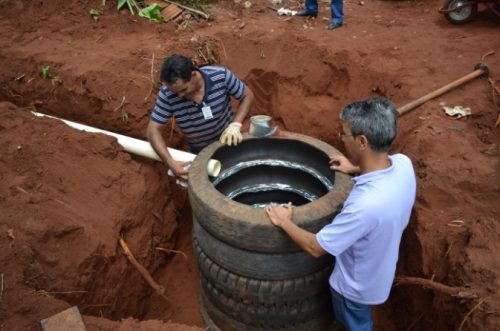How to remove and treat raw sewage is an issue in many different survival scenarios.
Here is one sustainable approach that could be applied virtually anywhere!
MATERIAL AMOUNT
Truck tires 8
5/8 screws 24
Iron bar 12 metres (4.8mm) 1
Iron bar 12 metros (6mm) 1
5/8 wide rim washers 48
Cement 1 and a half bag
Medium sand 24 cans
Gravel #5 6 cans
Aluminium foil tape 20 metres
PVC 90° quarter bend 100mm 4
PVC tube bar 100mm 3BUILDING YOUR SUSTAINABLE SEPTIC TANK
1. Choose the place to install the septic tank. The recommended distance is around 6 meters. The septic tank must be installed next to the toilet to avoid bends in pipes, and at a lower level of terrain, away from water wells. The minimum distance from a source of water is 50 metres.
2. Put the modules together. First, puncture the tires on the spots shown on the picture. Then, apply the aluminium foil tape between the tires before screwing them together. That foil blanket must be the same size as the tire circumference, and its purpose is to seal the modules, in order to prevent the sewage to spill.
3. The next step is to open the trench. The trench should measure approximately 1.4m depth, 1.5m width and 3m length.
4. You can make yourself the 2 rings and 2 reinforced concrete caps to install the pipe and close the septic tank. Use iron, sand, cement and gravel. Prepare the concrete mass and place it in the shape of the diameter of the tire circumference, with 14cm of height. The shape of the ring must have a way in and a way out for a 100mm pipe. The lids must have the same circumference of the tire and be 5cm tick. One of them will be compact and the other will have a central hole of 0.5 inch.
5. Place the modules in the trench. The bottom of each module must be compressed to receive a layer of concrete with at least 5cm. Then, install the rings.
6. Install the pipes. In the first module, install the access for the PVC pipe and 90° quarter bend with 90cm of depth. Install the exit pipe at the height of the first module and insert a 90° elbow on its end. That is 1.5m of tube, 20cm of which into the second module. On the end of it, install another 90° elbow and a tube with 90cm depth. The tube that will serve as a drain will be installed at the height of the second module. Next, apply aluminium foil tape between the tire and the rings.
7. Prepare a trench to bury the drain. The depth should be compatible with the slope of the terrain. Apply a layer of sand and gravel on the base. Before installing the 6m tube, make several holes 2m up from its edge, so that the liquid generated at the end of the process can infiltrate the soil. But be careful – it shouldn’t be directed to the vegetable garden.
8. Install the lid with a central hole in the first module and the compact lid in the second module. You must also install a pipe into the hole on the lid of the first module, with diameter of 0.5 inch and height of 1.5m, in order to release the gases that will be generated in the process. It must point upwards.
9. You have now reached the final stage of the construction and installation of the septic tank. Connect the first module to the toilet, using a 100mm tube. The length of the tube must observe the distance between the toilet and the first module.
In a survival situation, disposing of raw sewage safely is a critical need; improper disposal can lead to sickness and even death!
This sustainable septic tank system is relatively easy to make and very simple, but also very effective.
To learn more about this system, check out The Homestead Survival.
Featured Image via The Homestead Survival

Dinette Morris-bost Wren
John Tweedy
Instructions are sort of easy to get lost in, could definitely use a couple more pictures because the one showed here is the only one in the article.
Do better resurch- –
http://humanurehandbook.com/manual.html
2 55 gallon barels an pipe u done. The rest is bunch of s**t
a simple vid would be nice
this looks awesome
David Jewell
Brenda B Allen
What a stupid idea, wait till the local authorities see this!
It wouldn’t work in colder climates. It would freeze in winter. Youd have to bury the pipes below the frost.
Just build a trebuchet and launch your troubles into the next neighbourhood.
Mauricio Zapata Fernandez a eso me refería. Tiempo.atras.
Mary
Matt Holden
Christopher Green
primitive septic systems have the same issues as outhouses did, they can not support the required bacteria to fully decompose human waste. grey water is also an issue incase any chemicals are used in cleaning. a better solution that’s being used right now in 3rd world countries is simply separating the liquid waste from solids (urine from excrement). the urine (being almost completely sterile) is put on trees and shrubs while the solids are collected in a large, covered container, and given invertebrates that are specially cultivated to decompose human/animal waste. the affluent is then collected, and dried in the sun until all the liquid has been evaporated.
Vernon Ray Wren
Michael Kirk. An idea for your cabin?
Nick Greer, Bob Peisley
Umm I’m not going to be holding up that long to make a hole that big but I will be covering mine up
Your page SUCKS!!!!!!!!!